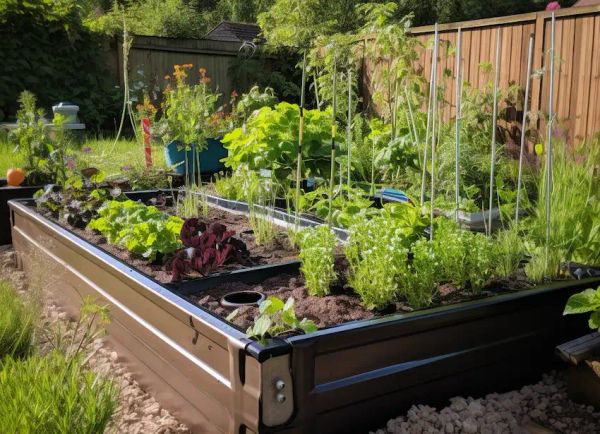In today’s urban landscape, finding green spaces can be a challenge. But fear not! The wicking bed is here to save the day and transform small spaces into thriving gardens. Not only is the wicking bed an innovative solution for gardening in urban environments, but it’s also a water-wise hero in the battle against drought and water wastage.

The Wicking Bed: A Clever System
Think of a wicking bed as a self-watering raised garden. It’s designed to be incredibly efficient with water by allowing plants to draw moisture upward from a built-in reservoir. This means you won’t have to constantly water your plants. How does it work? Through capillary action, just like when a paper towel soaks up a spill. The magic happens with an ‘L’-shaped pipe that evenly distributes water across the length of the bed and rises above the soil, making it easy to fill and monitor water levels.
Creating Your Own Garden Marvel
To build a wicking bed like the one in the photo you’ve provided, follow these step-by-step instructions to ensure your water distribution system works like a charm:
Choose the Right Container: Start with a sturdy container that can hold a large amount of soil and has space for a water reservoir underneath. Consider using a custom wooden frame, an old bathtub, or a repurposed large planter.
Seal It Up: Line the chosen container with a high-quality waterproof membrane to create the water reservoir. Make sure it’s completely sealed to prevent any leaks.
Install the ‘L’-Shaped Pipe: Lay a PVC pipe along the length of the bed on top of the aggregate. The pipe should have perforations along the horizontal section to distribute water evenly. Then, bend it upwards at one end, extending above the height of the bed for easy filling.
Add Coarse Aggregate: Fill the bottom of the bed with a layer of coarse aggregate, like gravel, and ensure it’s level. This is where your water reservoir will be.
Use a Geotextile Barrier: Cover the aggregate and the horizontal part of the pipe with a geotextile fabric. This will prevent soil from washing into the reservoir while allowing water to wick upwards.
Add Nutrient-Rich Soil: Pour a soil mix that’s rich in nutrients on top of the fabric. Make sure the soil is suitable for the types of plants you want to grow, whether it’s vegetables, herbs, or flowers.
Prevent Waterlogging: Install an overflow valve or pipe at the level where the soil meets the aggregate. This is crucial to prevent waterlogging by letting excess water escape.
Plant and Mulch: Now it’s time to plant your seeds or seedlings into the bed and cover the surface with organic mulch. Mulch helps reduce evaporation and keeps your plants happy.
Water and Enjoy: Fill the reservoir through the vertical pipe until water starts to overflow. Then, sit back and watch as your plants thrive with minimal maintenance, drawing up water from below.

By embracing the wicking bed design, you’re not just creating a beautiful garden, but also taking a step towards self-sufficiency and resilience in urban gardening. Let’s commit to a sustainable future where resource conservation and green living flourish in our cities.




